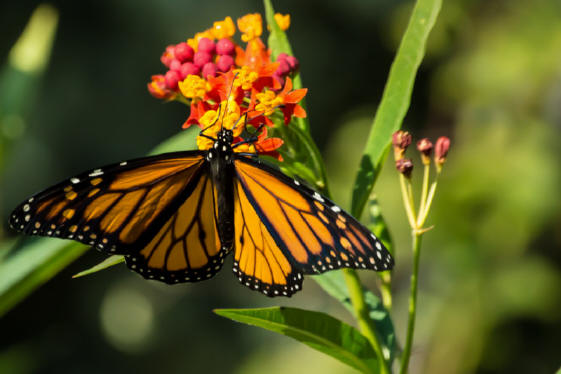How important are pollinators? For starters, around one-third of the human diet comes from insect-pollinated plants. Pollinators feed on flower nectar and carry pollen from one flower to another, while inadvertently pollinating them as they feed. Most pollinators are insects including butterflies, moths, bees, and ants. Hummingbirds also pollinate some plants. As gardeners, we must take action to help pollinators survive or our food supply will be threatened. Some of the vegetation in our area that need bees to pollinate include apple, apricot, blackberry, blueberry, cherry, cantaloupe, peach, pear, pumpkin, watermelon, and the list can go on and on.
It is important to choose annuals, perennials, and shrubs that love the heat and attract pollinators in our gardens. Native plants are great for attracting pollinators, since they are best adapted to the local growing conditions. Incorporating native flowers, shrubs, and trees into any landscape promotes local biological diversity and provides shelter and food for a diversity of wildlife. In order to create a habitat for a variety of pollinators, you need a diversity of plants that will bloom during several different seasons. I will present some pollinator-attracting plantings that are my favorites and are successful in my gardens, which are Penn State Master Gardener Certified Pollinator Friendly Gardens.

Coneflower (ital)(Echinacea purpurea)(end ital) is a perennial that provides sweet nectar to pollinators, especially butterflies and bees. Coneflowers prefer full sun.
Yarrow (ital)(Achillea millefolium)(end ital) is a perennial that has a distinctive fragrance that attracts butterflies, wasps, and bees. There are many colorful varieties and they are all excellent pollinator plants. Yarrow grows best in full sun
Bee balm (ital)(Monarda didyma)(end ital) is a perennial that is highly attractive to pollinators. The flowers are red and they attract hummingbirds, butterflies, bees, and moths. Bee balm is super easy to grow.
Hyssop (ital)(Hyssopus officinalis)(end ital)is a perennial that acts as a magnet for pollinators. It prefers well -drained soil and some shade from the hot afternoon sun. The flowers of the hyssop are tall and slender and bluish/purple in color. Honey bees make a rich and aromatic honey from this flower. Essential oils can be extracted from the flowers.
Lantana is an annual that provides nonstop color throughout the growing season. It is a member of the verbena (ital)(Verbenaceae)(end ital) family and there are many different flower colors for your selection. The flowers attract butterflies, hummingbirds, and bees. Lantana thrives in a hot and full sun environment and will continue blooming until the first frost.
Butterfly weed (ital)(Asclepias tuberosa)(end ital) is an excellent source of nectar for many butterflies, including Monarchs, hummingbirds, and bees. Female Monarchs will lay their eggs on the underside of the leaves, which is a vital food source for their caterpillars. Another benefit of planting butterfly weed is that it is deer and rabbit resistant. It prefers to grow in full sun.
Eastern redbud (ital)(Cercis canadensis)(end ital) is a small, graceful tree that is native to the eastern United States. It blooms before and as the leaves emerge, with rosy-pink, pea-like flowers. There are outstanding displays of this tree at the Gettysburg National Military Park.
Canna Lilies (ital)(Canna)(end ital) are annuals in Zone 6. They have rhizomatous bulbs that are easy to harvest in the fall and store in a dry basement or heated garage over the winter. It is well worth the extra labor to winterize these bulbs because of the beauty they provide. The flower color may be red, yellow, or orange. They prefer full sun and daily water. They showcase a garden and are striking in containers. Cannas are a magnet for hummingbirds because of the flower’s tubular shape.
In addition to growing pollinator-friendly plantings in your garden, it is also essential to provide a water source and nesting sites. Protect the pollinators by avoiding invasive plants and pesticides. Consider providing a habitat for pollinators in your gardens. You will enjoy the beauty of your gardens and also the excitement and thrill of watching the pollinators in action.
Read other articles on birds, wildlife & beneficial insects
Read other articles by Carolyn Black